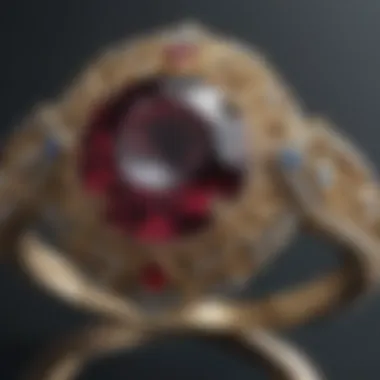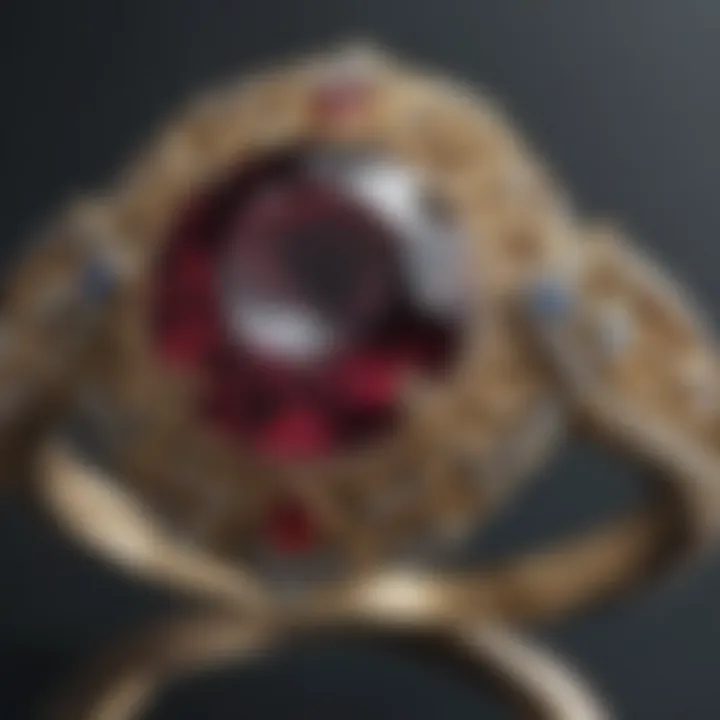The Art of Jewelry Design: A Comprehensive Exploration


Intro
The world of jewelry design is not merely about creating beautiful pieces; it goes far deeper than that. An exploration into this art form reveals multiple layers of creativity, technique, and historical context. By understanding how gemstones fit into this intricate puzzle, one gains a clearer perspective on what makes each handcrafted item uniquely special.
Jewelry has been cherished for centuries, serving not only as adornment but also representing cultural identity, social status, and even romantic intentions. This article embarks on a journey through the various facets of jewelry design, particularly focusing on gemstones—those captivating elements that can simultaneously enhance the visual appeal and the narrative behind each piece.
From uncovering the significance of materials to the historical paths that shaped our current perceptions, we'll dive into what truly lies at the heart of jewelry design. Let's begin by dissecting the gemstone’s nature and functions.
Gemstone Overview
Definition of Gemstones
Gemstones, in their simplest form, are precious or semi-precious minerals, often cut and polished for use in jewelry. They can vary widely in terms of rarity, color, and quality. This multifaceted nature makes them not just aesthetically pleasing but also valuable. Each gemstone possesses its own unique story, reflecting both natural processes and human artistry.
These gems are typically classified into two main categories: precious gemstones, such as sapphires, emeralds, and diamonds; and semi-precious gemstones, which include amethyst, topaz, and garnet. Understanding this classification aids designers and collectors in appreciating the diverse beauty found in each stone.
Classification of Gemstones
Gemstones can be classified based on various characteristics, including:
- Hardness: Measured using the Mohs scale, hardness indicates how resistant a gemstone is to scratching. Diamonds rank highest, while talc is the softest.
- Refractive Index: This is an essential feature determining how light interacts with a stone, influencing its brilliance and fire.
- Color: The hue, saturation, and tone of each stone contribute significantly to its overall appeal.
- Origin: Some gemstones are mined from specific locales known for their unique properties, like Burmese rubies which are highly esteemed for their rich color.
Each of these classifications plays a critical role in design choices, which will be further elaborated upon as we discuss craftsmanship and creativity in jewelry design.
"Gemstones are not only a feast for the eyes but also reflections of the earth's history, holding stories within their crystalline structures."
Moving forward, it’s vital to contextualize gemstones within the larger narrative of jewelry history, unlocking their significance in human culture and artistic expression.
Historical Significance
Origins of Gemstone Use
The use of gemstones in jewelry can be traced back thousands of years. Archaeological findings suggest that ancient cultures valued these precious stones not just for their beauty but also for their supposed magical and healing properties. The first recorded use of such stones dates back to the ancient Egyptians, who adorned themselves with lapis lazuli and turquoise, believing they conveyed protection and power. The ancient Greeks and Romans also favored gemstones, often associating them with various gods and using them to signify wealth and elegance.
Cultural Insights: Gemstones in Ancient Civilizations
Throughout history, gemstones have often been imbued with meaning, reflecting the values and beliefs of their respective cultures:
- Egyptians: Highly revered gemstones were thought to possess protective qualities.
- Greeks and Romans: Used gemstones in battles for power, often engraving them with symbols of their deities.
- Indians: The historical significance of gemstones in Indian culture is profound, entwining spirituality and tradition in various forms, from astrology to jewelry.
As we peel back the layers of history, it becomes evident that each gemstone encapsulates a piece of our collective human experience, acting as anchors to our past.
In summation, understanding the fundamentals of gemstones, their classifications, and their historical values provides a robust groundwork for anyone interested in the art of jewelry design. Next, we'll delve into the practical aspects of translating these concepts into modern design processes.
Prelude to Jewelry Design
Jewelry design stands as a remarkable art form that marries creativity with precision. It’s not just about making ornaments; it’s about crafting meaningful stories through materials, shapes, and design. The importance of this topic within our discourse cannot be overstated, as understanding jewelry design opens a window into the broader culture and history that surrounds these creations. The benefits of diving into this subject are multifold—whether one is a gemstone enthusiast, a collector, or a budding designer, each facet of this domain offers rich insights into artistry and craftsmanship.
Understanding the Essence of Jewelry
To truly grasp the essence of jewelry, we must first note that it is more than mere decoration. It serves as an expression of identity, culture, and emotion. Jewelry often marks important life milestones—be it an engagement ring signifying love, or a pendant passed down through generations. Each piece captures narratives that resonate far beyond their physical forms.
When considering elements such as gold, silver, or precious gemstones, we uncover that they hold significant cultural value. For instance, gold is often associated with wealth and permanence, while silver reflects elegance and versatility. These materials do not merely exist; they embody history, tradition, and sometimes, aspiration.
Moreover, designs can invoke emotions or signify relationships. An intricate design might remind one of a lost loved one, while a bold piece may encapsulate a celebratory spirit. Hence, understanding these connections forms the heart and soul of jewelry design.
The Historical Context of Jewelry Design
The story of jewelry design isn’t just modern; it’s as ancient as civilization itself. Each era has left its mark on the way jewelry is understood and produced. From the delicate gold leaf ornaments of ancient Egypt to the ornate pieces of the Renaissance, every historical context adds layers to our understanding.
The evolution of techniques and materials reflects societal changes. For example, during the Art Deco period, the focus shifted toward geometric patterns and flamboyance, mirroring the dynamic cultural shifts of the time. Today, vintage and retro styles have resurfaced, reminding consumers of the cyclical nature of design.
Additionally, countless cultural influences shape contemporary jewelry design. Designs often tell stories of where they originate, showcasing unique craftsmanship from different regions. From Japanese minimalist aesthetics to intricate Indian designs, the variety is staggering. Understanding these contexts enhances appreciation, allowing us to become discerning collectors or savvy designers.
"Jewelry is like a biography. A story that tells the many chapters of our lives."
The Ideation Process
The ideation process stands as a cornerstone in the realm of jewelry design, shaping not only the artistic vision but also laying the groundwork for practical execution. This phase bridges the gap between mere creativity and tangible craftsmanship. Engaging in the ideation stage fosters a profound understanding of the jewelry maker's intent. It allows them to explore possibilities and carve out a niche within an often saturated market. In essence, the ideation process serves as the backbone of successful jewelry creation, encouraging designers to think beyond aesthetics and prioritize innovative functionality.
Inspiration Sources
Inspiration often strikes like a lightning bolt, illuminating the mind with endless possibilities. Yet, where does a jewelry designer find these sparks? The sources of inspiration are as varied as the designs themselves. Nature is a wellspring of creativity; the intricate patterns in leaves, the vivid hues of gemstones, and the elegance of organic forms fuel design ideas. Artists and architects also offer inspiration – their work can evoke emotions or concepts that translate beautifully into jewelry.


Furthermore, cultural elements play a significant role. Traditions, folklore, and historical motifs provide a rich tapestry from which interesting pieces can emerge. For instance, Japanese Kintsugi art celebrates the beauty in imperfection, encouraging designers to embrace flaws as unique identities for their pieces.
- Nature: Floral designs, mineral structures, ocean waves
- Art: Abstract paintings, sculptures, architectural forms
- Culture: Traditional crafts, ancient symbols, regional styles
Retail spaces too can inspire; observing trends in boutiques or art shows informs designers about popular materials and emergent styles. Social media platforms like Instagram serve as a virtual mood board, connecting designers with global trends and artistic influences.
Sketching and Conceptualization
Transforming vibrant ideas into visual representations is a critical phase in the jewelry design process. Sketching serves as a preliminary exploration tool, allowing designers to experiment with different shapes, sizes, and textures. This hands-on engagement is vital because it helps refine thoughts into coherent concepts.
During this stage, the designer might create multiple sketches for a singular idea, iterating over and over to determine the most effective visual representation. Sometimes, the initial concept may evolve dramatically through sketches, unveiling unexpected beauty or functionality. The flexibility of this stage encourages designers to think outside the box, free from the constraints of materials or production techniques.
"A sketch is not just a plan; it's a dialogue between the designer and their vision."
Once sketches solidify, the next step is conceptualization, where designers consider practical aspects along with aesthetic ones. Questions arise: How will the piece be worn? What materials fit the vision? At this juncture, it’s imperative to weigh both beauty and functionality—designers need to ensure their creations are not just visually impressive but also wearable and resilient.
Materials and Techniques
When it comes to jewelry design, selecting the right materials and techniques is foundational. The choices a designer makes not only define the final product’s aesthetic but also its durability, wearability, and overall value. Meticulously chosen materials paired with refined techniques can elevate design into an experience, transforming mere objects into cherished possessions.
Choosing the Right Materials
Choosing materials is more than a question of personal preference; it is about understanding the properties and implications of each option.
Metals: Gold, Silver, Platinum
Gold, silver, and platinum shine brightly in the world of jewelry, each carrying its own unique story. Gold, with its timeless luster and historical significance, is a symbol of wealth and status. It’s resistant to tarnishing, making it a popular choice among jewelers and collectors alike. However, one should also note that gold comes in various karats, altering its purity and hue.
Silver, on the other hand, offers a stunning appearance at a more attainable price point. But it is softer than gold, making it susceptible to scratches and tarnishing when exposed to air and moisture. So, a bit of extra care is required, but many see it as worth the effort for its beauty. Lastly, platinum stands as the heavyweight champion of metals. It’s extraordinarily durable and incredibly dense. Known for its hypoallergenic qualities, it’s perfect for those with sensitive skin. The only catch is its price; being rarer than gold and silver means you will pay more for its premium qualities.
Gemstones: Selection and Quality
When selecting gemstones, quality reigns supreme. Every gemstone tells a story through its color, clarity, cut, and carat weight—often referred to as the four Cs. A gemstone with pristine clarity and a vibrant color will undoubtedly capture the eye and elicit admiration. It’s paramount to consider not just beauty but also durability; some stones are more suitable for daily wear than others. For example, sapphires and rubies are known for their toughness, while opals may require more care.
Moreover, the ethical sourcing of gemstones is becoming increasingly important to many consumers. Collectors and designers are now opting for conflict-free stones or lab-grown alternatives, which can provide a more sustainable choice without sacrificing beauty. The delicate balance between ethical considerations and aesthetic appeal adds a fascinating dynamic to the selection process in jewelry design.
Crafting Techniques
The processes within jewelry design have evolved, becoming a blend of artistry and technology. Here's a look at two fundamental crafting techniques that every designer should understand.
Handcrafting vs. Machine-Made
Handcrafted jewelry embodies a personal touch that speaks to sentiment and artistry. Each piece carries the artist's unique fingerprint, making it distinct. Handcrafted pieces often allow for more intricate detailing and customization compared to machine-made alternatives. However, this type of craftsmanship can be time-consuming and may come at a higher price point.
On the flip side, machine-made jewelry offers precision and uniformity that’s hard to replicate by hand. This can significantly reduce production time and costs, allowing designers to produce collections quickly and efficiently. Yet, some purists argue that this mass production can lead to a loss of artistry in design. While both methods have their merits, a savvy designer often finds a balance, choosing when to utilize technology and when to lean into their craftsmanship.
Setting Techniques
The method of setting gemstones significantly affects not just the beauty but also the integrity of the design. Bezel setting, for example, provides security for the stone while offering a sleek, modern look. This technique encircles the gemstone with metal, ensuring it stays put—even under rigorous daily use. Meanwhile, prong setting allows for maximum exposure to light, enhancing the brilliance of the gems but can leave them more vulnerable.
Other popular techniques include channel and pave settings, each adding a unique flair to a piece. Understanding these options not only informs the designer's aesthetic but also engages the practical concerns surrounding wearability and long-term preservation of the jewelry.
"Material choices and crafting techniques are the bedrock of a jewelry designer's vision; they define the marriage of artistry and everyday utility."
As seen above, materials and techniques in jewelry design demand careful consideration. Having a solid grasp of the metals and gemstones available and the methods used in crafting helps designers bring their ideas to life while catering to the expectations of discerning clientele.
With these fundamentals understood, artisans can push creative boundaries further, ensuring their designs are not just visually striking, but are also practical and enduring.
The Role of Technology in Jewelry Design
In today’s fast-paced world, technology has made its way into nearly every facet of design—and jewelry is no exception. The role of technology in jewelry design is far-reaching, influencing everything from initial concepts to the final production of pieces. It doesn’t just enhance the creative process; it uplifts the entire industry, making it more efficient, precise, and accessible to those who dare to tread its intricate paths. By integrating advanced methods and tools, designers can bring their visions to life with precision and creativity that was previously unimaginable.
One significant advantage of technology in jewelry design is the ability to experiment with various materials and styles without the hefty costs associated with traditional methods. Designers can play with new concepts in a digital space, ultimately leading to more innovation and a broader range of choices for consumers. Furthermore, technology enables designers to better meet market demands, adapting quickly to trends that shift like sand.
3D Modeling Software Applications
3D modeling software stands at the forefront of technological advancements in jewelry design. Programs like Rhino, MatrixGold, and Blender allow designers to create intricate drawings in virtual spaces. These tools offer immense flexibility; designers can manipulate shapes, colors, and even simulate how light interacts with the gemstones.
With a click of a button, adjustments can be made in real-time, cutting down the time spent on physical prototypes. This sort of efficiency is invaluable. In essence, the 3D applications transform a designer’s sketch into a tangible model that can be visualized from every angle.
The benefits of 3D modeling extend beyond mere visualization. Patterns can be optimized for manufacturing processes. For example, designs that seem stunning on paper might not be practical for metal workers, but with 3D tools, adjustments can be made seamlessly to ensure manufacturability. It can also be used to prepare files for 3D printing, which has become an important technique in the rapid prototyping and manufacturing of unique pieces.
Prototyping and Advancements
In the jewelry design realm, prototyping serves as a crucial bridge between concept and reality. The advancements in technology have dramatically revolutionized the prototyping stage. Now, designers can utilize techniques like 3D printing to create prototypes swiftly and accurately. This method not only reduces the amount of time and resources needed but also allows extensive testing and modification, cementing the design’s practicality before any gemstones or metals are introduced.


Moreover, advanced materials used in 3D printing—such as resin or precious metal filament—enable designers to produce prototypes that closely resemble the final product. This can greatly aid in visualizing the weight, feel, and overall aesthetics of the piece.
There is little doubt that technology is transforming how jewelry is designed and manufactured. As these tools continue to evolve, so will the possibilities for designers. Collaborations with engineers and scientists are leading to further innovations, allowing them to explore uncharted territories in material science and product design.
"Technology not only broadens the horizons for what is possible in jewelry design but also invites a new generation of creators to express their visions with newfound tools and techniques."
In summary, the infusion of technology into jewelry design gears itself towards efficiency, creativity, and practicality. Designers are better equipped than ever to develop meaningful, functional, and visually striking pieces, ensuring that the art of jewelry remains dynamic in an ever-changing market.
Designing with Functionality in Mind
In the realm of jewelry design, the adage “form follows function” rings especially true. While the visual appeal of a piece can often take center stage, the significance of functionality cannot be overstated. Designing with functionality in mind transforms jewelry from mere adornment into a practical accessory that complements the wearer’s lifestyle. It creates a harmonious balance between artistry and usability, ensuring that pieces not only look good but also serve a purpose in everyday life.
Balancing Aesthetics and Wearability
It's all well and good to have a stunning pair of earrings that dazzle at first glance, but if they cause discomfort after a couple of hours, one might think twice before wearing them again. Achieving the right balance between aesthetics and wearability is crucial. Designers must take into account the weight of materials, the length of chains, and how a piece interacts with movement. For instance, heavier pieces can feel burdensome, leading to discomfort over time.
Moreover, the choice of materials plays a pivotal role. Light materials like titanium or certain plastics can provide both visual interest and comfort, allowing for longer wear. Incorporating ergonomic designs—like adjustable rings or flexible bracelets—can also enhance functionality while maintaining a sleek look.
Some key considerations include:
- Weight Distribution: Ensuring an even weight across the piece.
- Adjustability: Designing elements that can adapt to fit various sizes.
- Safety: Incorporating secure clasps that prevent loss.
Thus, the challenge for jewelry designers lies in creating pieces that reflect their artistic vision without perplexing the wearer's everyday experiences.
Considerations for Everyday Jewelry
When discussing functionality, the type of jewelry designed for daily wear warrants a closer look. Everyday jewelry must endure a variety of activities and environments while still looking appealing. Here are several factors to consider when creating such pieces:
- Durability: Opt for materials that withstand wear and tear. Stainless steel or sterling silver are popular choices due to their resilience.
- Versatility: Pieces should complement various outfits—from casual to formal. A simple pendant or a classic pair of hoop earrings can transition seamlessly throughout the day.
- Maintenance: How easy is it to clean the piece? Designs should minimize crevices that trap dirt but still maintain an artistic edge.
"The best pieces of jewelry are those that tell a story, yet are comfortable enough to wear every day."
The true art of functional jewelry design lies in understanding the wearer's needs and marrying those with aesthetic appeal. The outcome is a collection of pieces that one doesn’t only cherish visually but also finds practical for the hustle and bustle of daily life.
Trends in Jewelry Design
In the dynamic world of jewelry design, understanding trends is essential for those who want to stay ahead of the curve. Trends not only reflect the tastes and preferences of consumers, but they also shape the direction of future designs. They play a significant role in the marketing strategies and business decisions of designers, jewelers, and brands. When one keeps their finger on the pulse of these trends, it opens up opportunities for connection with the audience. A thoughtful approach to trends allows designers to cater to market demands while expressing their creativity.
"Jewelry should not be seen as an accessory, but an extension of the self; trends help shape this expression."
Current Design Trends
Today’s jewelry scene is a melting pot of various influences. Designers are exploring innovative solutions and styles that cater to multiple consumer needs. Some of the notable current trends include:
- Mixing Materials: Combining metals such as gold with unexpected materials like acrylic or textiles is gaining popularity. This eclectic mix fosters a unique aesthetic that resonates with a diverse audience.
- Bold Gemstones: Vibrant, oversized gemstones are making a statement. Designers are opting for striking colors and unconventional cuts that draw attention and spark conversations.
- Minimalist Designs: Contrasting bold pieces, minimalist designs are capturing hearts for their simplicity and elegance. Delicate chains, small stud earrings, and subtle rings appeal to those who prefer understated beauty.
- Personalization: Customized jewelry is carving a niche in the market. From engraved names to birthstones, personalized items create a meaningful connection between the wearer and the piece, making it more valued.
- Vintage and Retro Styles: The nostalgia for bygone eras is influencing new designs. Styles from the Art Deco period, for example, are being revived through modern techniques and materials, appealing to the desire for unique and timeless pieces.
Sustainable and Ethical Practices
As consumer awareness grows, the demand for sustainable and ethical practices in jewelry design has taken center stage. Increasingly, buyers are considering the environmental and social impacts of their purchases. For designers, this means not only sourcing materials responsibly but also considering the entire lifecycle of their creations.
- Sourcing Ethically: Designers are opting for conflict-free diamonds and recycled metals. This conscious choice signals a commitment to ethical practices and resonates with values-driven consumers.
- Eco-Friendly Materials: The use of biodegradable or recycled materials is on the rise. Some designers are working with lab-grown diamonds and gemstones, which reduce the environmental impact and provide a sustainable alternative to mined stones.
- Transparency: Consumers today want to know the story behind their jewelry. Brands that clearly communicate their sourcing, manufacturing processes, and labor practices build trust and loyalty among consumers.
- Social Responsibility: Brands are also engaging in responsible manufacturing practices, ensuring fair wages and safe working conditions. Collaborating with artisans and communities can help uplift marginalized groups while creating beautiful pieces.
Understanding Market Demands
In the world of jewelry design, understanding market demands is like having your finger on the pulse of what consumers want. It’s about knowing not just the trends, but the deeper sentiments that influence buying behaviors. Designers who grasp these demands can tailor their creations to resonate with their target audience and stand out amidst a sea of competitors.
Why It Matters:
Market demands dictate what materials are sought after, the complexity of designs, and even the price points that consumers are willing to accept. A well-informed designer is better equipped to determine which genres—be it elegant evening wear, casual everyday pieces, or trendy statement items—will thrive in today's ever-evolving landscape.
Identifying Target Audiences
Identifying the target audience is a fundamental step in jewelry design that can’t be overlooked. It’s akin to finding the right ingredients before cooking a meal. Wines, pearls, or fancy diamond rings are not for everyone.
- Demographics: This includes factors like age, gender, income levels, and cultural background. For instance, younger audiences may lean toward more unconventional designs with a playful edge, while older generations might prioritize timeless elegance.
- Psychographics: Understanding the desires and values of your potential customers can offer a gold mine of information. Many buyers are looking for unique items that speak to their personality or story, particularly among those who collect handmade or artisanal jewelry.
- Lifestyle and Preferences: Take into consideration what your audience values in terms of sustainability, ethics, and overall fashion sense. For example, eco-conscious consumers might prefer ethically sourced gemstones and recycled metals, prompting designers to adjust their material choices.
By creating customer personas, jewelers can tailor their designs to meet specific needs rather than trying to please everyone. This targeted approach not only enhances customer satisfaction but also improves brand loyalty over time.
Pricing Strategies
Once the target audience is identified, the next logical step is formulating effective pricing strategies. The way a piece is priced can significantly affect its perceived value and market appeal.
- Cost-Plus Pricing: This is a straightforward approach where the production cost is calculated, and a markup is applied. Knowing the materials and labor costs allows designers to set prices that ensure profitability while remaining competitive.
- Market-Oriented Pricing: This technique involves analyzing competitor prices and demand in the market. It helps designers gauge what similar items are selling for and adjust their prices accordingly. The trick here is to create a balance—to provide value without undervaluing the artistry involved in the design.
- Dynamic Pricing: Jewelry designers can also use dynamic pricing strategies that may change based on seasonality, special promotions, or shifts in consumer behavior. For instance, limited-edition pieces could be priced higher due to their exclusivity.
Quality must not be sacrificed for affordability. Jewelers should communicate the craftsmanship behind their jewelry effectively, so buyers appreciate what they are purchasing — especially for higher-priced items which are often viewed as an investment.
The Role of Branding in Jewelry Design


In the realm of jewelry design, branding functions like the sparkle of a well-cut diamond—it catches the eye and holds the attention of potential buyers. A strong brand identity can set a jewelry designer apart in an oversaturated market, making it imperative for designers and businesses to cultivate their unique narratives. When people select a piece of jewelry, they often do not just see an accessory; they are purchasing a story, an emotion, and sometimes, an experience. Hence, understanding the role of branding is essential as it encompasses what a brand represents in the eyes of consumers.
Creating a brand is not merely a matter of logo design or clever marketing; it’s about building trust and establishing a connection with the audience. Whether it's a precious gemstone ring or an elegant necklace, consumers seek authenticity. This necessity for reliability highlights why branding transcends mere aesthetics—it’s about emotional resonance.
Creating a Unique Identity
To forge an identity that resonates, designers need to consider several key aspects. This identity goes beyond aesthetics and deeply intertwines with the core values and mission of the brand. Here are some elements to mull over:
- Vision and Values: Think about what your jewelry represents. Are you aiming for sustainability, luxury, or uniqueness? Define these clear values from the outset.
- Target Audience: Consider who you want to reach. A luxury brand might appeal to affluent customers, while handcrafted pieces could attract those who value artisanal craftsmanship.
- Visual Elements: Colors, typography, and materials used should align with the message a brand wants to convey. The identity must be consistent throughout all branding channels from social media to physical packaging.
Embedding storytelling into branding can serve as a powerful magnet. For example, if a designer sources gemstones from ethically sustainable mines, weaving this story into marketing efforts can captivate potential buyers who desire to make conscious choices. As brands evolve, they must keep their identity relevant yet distinct against ever-changing market dynamics.
Effective Marketing Techniques
Having a distinctive identity is just part of the equation; next comes the challenge of spreading the word about it effectively. This is where marketing techniques come into play. Here are some strategies that jewelry designers can use to effectively promote their brand:
- Social Media Presence: Platforms like Instagram or Pinterest allow designers to showcase their work visually. Engaging with followers through behind-the-scenes content can build a loyal community.
- Collaborations: Partnering with other artisans or brands can enhance visibility. A well-planned collaboration can bring fresh ideas and audiences together, allowing for cross-promotion.
- Influencer Marketing: Enlisting influencers who resonate with the brand can reach a broader audience. It's crucial to choose individuals who align with the brand’s values.
- Content Marketing: Blogs or video tutorials about jewelry care or design processes can help engage the community and position the brand as an authority in the field.
Effective marketing not only promotes products but also conveys the essence of the brand's identity, turning potential customers into advocates.
Caring for Your Designs
Caring for your jewelry is not just about maintaining its appearance. It involves understanding the art of preservation, which is crucial to sustaining its allure and value over time. Jewelry, be it a simple silver ring or an intricately designed gemstone necklace, often carries significant sentimental value and, in many cases, financial investment. Proper care can prolong its life and legacy, converting everyday pieces into heirlooms worthy of passing down through generations.
When it comes to your jewelry collection, take into account the environment it exists in—the humidity, temperature, and exposure to various pollutants can all contribute to wear and tear. In essence, caring for your designs is about recognizing that they need protection and attention, just as the artists who made them dedicated time and effort into crafting each piece.
Maintenance Tips
To ensure your jewelry pieces stay in top shape, consider the following maintenance tips:
- Regular Cleaning: Gentle cleaning can make a world of difference. For most jewelry, a soft cloth to gently wipe down the metal and stones is effective. Avoid using harsh chemicals, especially on softer gemstones.
- Storage Solutions: Store pieces in a safe, dry place. A jewelry box lined with cloth or designated pouches can prevent scratches and tangling. Keep items like necklaces and bracelets separate to avoid entanglement.
- Inspect for Damage: Make it a habit to check your jewelry regularly for any signs of wear. Look for loose stones, fraying chains, or bending clasps. Early detection can save you from costly repairs down the line.
- Keep Away from Chemicals: Household products such as perfumes, hairsprays, and cleaning agents can accidentally tarnish or damage your jewelry. As a rule of thumb, put on your jewelry after completing your daily grooming routine.
Remember, a little upkeep goes a long way!
"Jewelry is a way of keeping memories alive, so take care of those memories."
Restoration and Repair
Even with the best care, jewelry can succumb to the ravages of time or accidents. Understanding when and how to restore or repair a piece is vital for any collector or designer. Restoration might involve a deep cleaning and polishing, while repair could mean fixing a broken clasp or resetting a gemstone.
When considering restoration, think about:
- Professional Assessment: If you notice damage, seeking the help of a professional jeweler ensures that the repair is done correctly and carefully. Some gemstones require specialized care, and an expert can navigate these nuances.
- Don’t DIY Too Soon: While some minor fixes are straightforward, attempting to handle intricate repairs without the proper skills can lead to further damage. Always evaluate whether the potential cost of a mistake outweighs the ability to DIY.
- Emotional Value vs. Material Worth: Sometimes, the connection to a piece outweighs its monetary value. If you have a family heirloom, opting for restoration rather than replacement ensures that the memories it holds remain intact.
By prioritizing the care, maintenance, and potential restoration of your jewelry, you not only preserve its physical beauty but also nurture the stories they tell. Investing time in the upkeep of your designs respects both the craftsmanship behind them and their place in your life.
The Future of Jewelry Design
The future of jewelry design is a fascinating topic that holds immense significance in the broader discussion of this craft. As we look ahead, it’s clear that the evolution of technology, changing consumer preferences, and heightened awareness of sustainability are all influencing trends in this artistic field. Designers have to be adaptable, innovative, and forward-thinking to keep pace with these shifts. The importance of this topic lies not just in recognizing these trends, but in understanding how they shape the very essence of jewelry design—what consumers seek and how artisans fulfill those desires.
Innovations on the Horizon
Innovations in jewelry design are setting the stage for an exciting future. Advanced technologies, such as 3D printing, artificial intelligence, and virtual reality, are more than mere novelties; they're becoming integral tools for designers. 3D printing allows the creation of intricate designs that were once impossible, giving designers the freedom to explore complex patterns without the typical material constraints. Additive manufacturing also reduces waste, aligning with a global push towards sustainability.
Moreover, artificial intelligence assists in design by analyzing trends and consumer behavior, enabling designers to create pieces that resonate with their target audience. Imagine a tool that can suggest designs based on current social media trends or customer preferences, transforming the conventional design process.
Lastly, augmented and virtual reality technologies provide an immersive experience for customers. Picture trying on jewelry pieces in a virtual environment before making a purchase; this level of interaction enhances customer satisfaction and reduces the likelihood of returns.
Global Influences and Collaborations
Global influences in jewelry design usher in fresh ideas and perspectives, creating a richer tapestry of styles and techniques. As designers collaborate across borders, they blend cultural elements into their work. Whether it’s the use of traditional design motifs from Africa or the delicate craftsmanship techniques found in Japanese art, such collaborations expand the creative horizon.
- Cultural Fusion: Designers are increasingly drawing inspiration from various cultures, creating pieces that resonate on multiple levels.
- Artist Collaborations: Partnerships between jewelers and visual artists or fashion designers challenge the norms of jewelry art, pushing boundaries that can lead to unique pieces.
- Material Sourcing: Global connections also aid in sourcing rare materials, whether it’s ethically mined gemstones or sustainable alternatives. Such practices align with growing consumer demands for responsible sourcing.
The global stage provides an opportunity for jewelry makers to showcase their uniqueness. As artisans intertwine their narratives, the future will undoubtedly see more innovative designs that reflect an amalgamation of ideas, techniques, and traditions. This interconnected world is likely to sow the seeds for the next wave of exceptional jewelry design.
Culmination
The significance of the conclusion in an article about jewelry design stretches far beyond a mere summary. It's a final opportunity to reflect on the intricate journey that designers embark upon from the initial spark of inspiration to the polished piece of jewelry ready for admiration. Each section we've explored in detail holds a thread that weaves into this comprehensive narrative. It’s crucial for readers—whether they're gemstone enthusiasts, collectors, or budding jewelry designers—to grasp how each element, like materials and techniques, plays an integral role in the overall design process.
Evaluating what has been discussed, the importance of creativity must be highlighted. Without taking bold liberties in design choices, the jewelry world would stagnate. Each original piece not only showcases the artist's vision but also resonates with potential buyers who seek unique expressions of beauty.
Furthermore, understanding market demands and trends positions designers to create pieces that marvel and captivate. This dynamic interplay between artistry and audience is a delicate balancing act that defines successful jewelry designers. As we see, the jewelry world adapts, shifts, and evolves, often reflecting broader cultural currents while retaining a distinct identity.
Additionally, caring for jewelry cannot be understated. Maintaining, restoring, and properly caring for these delicate creations extends their life and ensures each piece tells its own story for years to come. This commitment to preservation enriches the relationship between the wearer and their adornments.
"Jewelry is like the perfect spice—it always complements what's already there."
Both experienced designers and novices alike can benefit from the understanding that every detail matters. It is not solely about aesthetics, but also about the legacy of craftsmanship. With environmental considerations becoming increasingly pressing, the integration of sustainable practices is now more essential than ever. As consumers lean towards ethical considerations, designers must adapt to these growing demands.
In essence, concluding this exploration prompts readers to not only appreciate the beauty of jewelry but also consider the thoughts, emotions, and values that reside within each piece. The art of jewelry design is truly a holistic endeavor, inviting a deeper understanding and connection with the craft.



